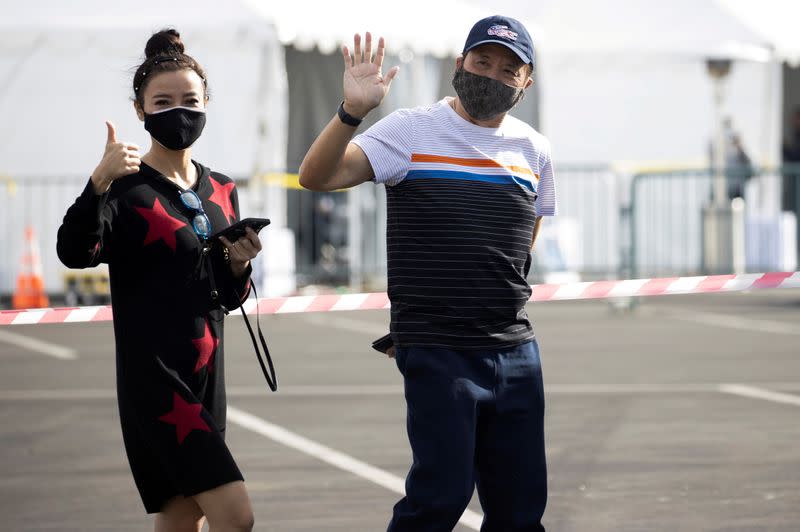U.S. economic bridge may finally span pandemic's end as benefits, vaccines both roll on
By Howard Schneider and Ann Saphir
WASHINGTON/SAN FRANCISCO (Reuters) - Good news came in a bundle this week for workers furloughed last year from the Walt Disney Co.'s California theme park.
The company said it would bring back a first tranche of 10,000 employees as it readies to reopen Disneyland in late April, and for those who don't get that first round call or aren't comfortable returning to work yet because of the pandemic, President Joe Biden's stimulus bill, signed on Thursday, extends their unemployment benefits through the summer.
It is arguably the first time since the crisis erupted in the United States a year ago that the potential end of the health emergency and the economic response to it have overlapped, and service union official Stephen Boardman says his members are ready for the pandemic epoch to end.
"Many, many will go back," when called to their former jobs as janitors, food servers, ticket takers, and security guards, said Boardman, a spokesman for the SEIU-USWW union, one of about a dozen unions that represent employees at Disneyland, which has hosted a mass vaccination site in a parking lot at the Anaheim, California amusement park since January.
The rest now have support coming from one-time government payments of $1,400 per person, monthly tax rebates for families with children, and $300 per week in federal unemployment benefits running through Labor Day in early September.
That has prompted economists to boost their projections for U.S. growth this year and led some to anticipate the "V" shaped rebound that seemed out of reach last year as the coronavirus crisis surged.
Graphic: Forecasts point to a better outcome - https://graphics.reuters.com/USA-ECONOMY/FORECASTS/azgpoezwbpd/chart.png
The $1.9 trillion in the bill won't all be disbursed this year, and economists note some of the programs, like unemployment benefits, will pay out less if the stimulus is successful and people return to work.
The legislation doesn't so much fundamentally rewire the economy as bolster the temporary lifelines first offered in last spring's CARES Act, said TS Lombard economist Steven Blitz. He estimated only about $1.1 trillion of the funds will be spent in 2021.
Still, it should complete the economic "bridge" officials have built in fits and starts since the pandemic washed over the country last year and triggered a state of emergency on March 13 that remains in effect.
If the current U.S. vaccination pace continues, much of the population will be at least partially inoculated by Memorial Day weekend in late May.
Last year, that traditional U.S. kickoff to summer served as a portent of the deadly months to come, with images of maskless beach and lake parties showing just how willing Americans were to ignore health experts.
More than half a million people died, and top health officials still worry the country will move too fast in getting back to normal and risk a relapse.
Graphic: Oxford Economics Recovery Index - https://graphics.reuters.com/USA-ECONOMY/OXFORDINDEX/yzdvxqzmkpx/chart.png
'MASSIVE RAMP-UP PLANS'
At this point, however, there seems some grounds for optimism.
The growth in cases is slowing, and households now have an income buffer for another five months, time for the pandemic to abate more fully and for companies to follow Disney's lead.
There are plenty who still need help. Last week another 712,000 filed initial claims for unemployment, and more than 20 million continued collecting benefits in late February. Those numbers may not come down fast until the virus recedes enough that the most damaged parts of the economy, particularly the travel and hospitality industries, can fully reopen.
Graphic: A varied rebound: Weekly foot traffic vs. 2019 - https://graphics.reuters.com/USA-ECONOMY/STIMULUS/jbyvrajzepe/chart.png
The economy may be gaining traction.
On eight of the last 14 days, the Transportation Security Administration cleared more than a million people per day to board airplanes, the first such stretch during the pandemic outside of the Christmas and New Year's holiday weeks.
Graphic: Air travel still low, but fighting back - https://graphics.reuters.com/USA-ECONOMY/STIMULUS/yxmvjwokrpr/chart.png
The numbers of people eating at restaurants has begun rising, data from reservation site OpenTable shows. While still low overall, in states like Texas and Florida patronage at reopened restaurants is more than 80% of a year ago, just before the pandemic - a sign people are willing to return to in-person activities as they become available.
Graphic: If it's open they will come - https://graphics.reuters.com/USA-ECONOMY/STIMULUS/qzjpqlkeevx/chart.png
Shift work at a broad set of industries jumped in the first week of March to nearly 90% of the pre-pandemic level, according to time management firm UKG, the highest reading in its labor index since last spring's jobs crash. Data on small businesses provided by time management company Homebase have also seen a steady rise in employment this year.
Graphic: Jobs in real time - https://graphics.reuters.com/USA-ECONOMY/REOPENING/azgvoaggdvd/chart.png
Beyond private business, school reopenings should mean the rehiring of bus drivers, cafeteria workers and others furloughed last year, and may speed the return to work of mothers and fathers unable to leave the home.
For trade show company Freeman, whose business was decimated by COVID-19, the future seems to be falling into place.
Chief executive Bob Priest-Heck surveyed about 300,000 exhibitors and other customers in February and found about 78% plan to attend in-person events in the fall - compared with 60% in a survey just a month earlier and about equal with a normal year.
Event bookings for the 12 months beginning in July are already at $1.2 billion, an encouraging base to build towards the company's pre-COVID annual revenue of around $2 billion, and a signal to plan more staffing. As it stands the firm expects to bring back at least 1,400 of the roughly 4,000 let go during the pandemic, and more as needed.
"Bookings are really materializing in the fall," Priest-Heck said. "I think we are going to have a really strong recovery ... We have massive, massive ramp-up plans."
(Reporting by Howard Schneider; Editing by Dan Burns and Andrea Ricci)

 Yahoo Finance
Yahoo Finance 

